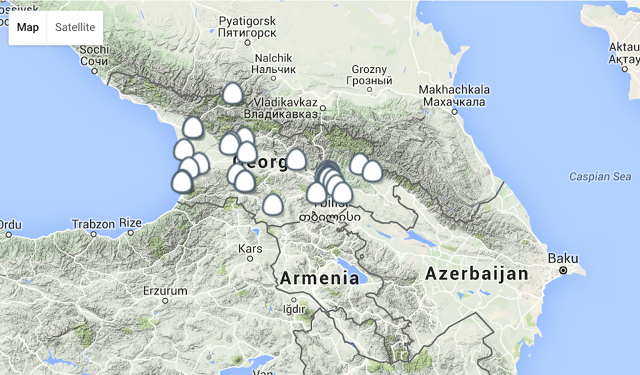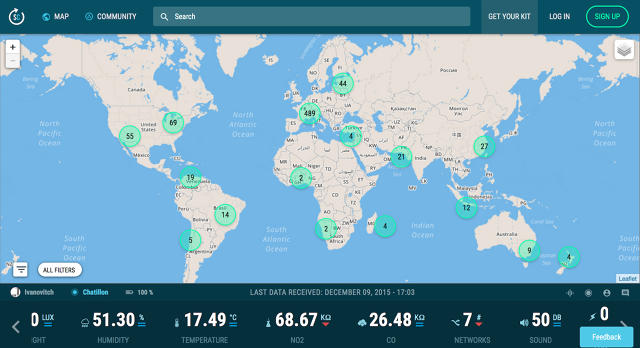How the sector Will transform once There Are Environmental Sensors in all places
As sensors become small and low cost, we’re growing a world community of environmental information collection to lend a hand us figure out the most effective the way to quickly lower emissions.
January 7, 2016 topics that largely breed gloom, like international warming and urban decay. A VP at the Frankfurt office of research firm Gartner, she believes that the present explosion of little internet-related sensors can alternate how cities use energy and make pollution—and that common electorate can play a job. “folks in China grow to be extraordinarily disenchanted with the environmental performance of their u . s . a .,” says Tratz-Ryan, as Beijing suffers below a few of its most-poisonous smog ever. Even in that tightly controlled society, activists are having victories, she says, pointing to public protest that just lately stopped the siting of a waste incinerator in the city of Luoding.
voters are turning into more powerful, she says, due to small, reasonably priced sensors that they can use to gather different environmental data. “Ten years ago, [sensors were] in big structures or these huts established in downtown areas,” she says. “[Now], we in truth have smaller varieties of sensors that may be both related to a mobile phone or to a automotive or a bicycle.”

In a document from closing year that Tratz-Ryan co-wrote, Gartner estimated that through 2019, “citizen environmentalists” will have deployed extra personal sensors, measuring things like air and water air pollution, than governments have in countries with well developed economies. good Citizen kits, as an example, are palm-sized containers that measure the important thing air pollutants carbon dioxide and nitrogen dioxide (NO2), in addition to humidity, temperature, and noise ranges. knowledge is uploaded to the smart Citizen site, which displays about 800 kits deployed world wide, more than half of them in Europe. the basic kits price about $one hundred seventy, sooner than tax and transport. smart Citizen’s Guillem Camprodon tells me by means of e mail that they are trying to get the associated fee down, but that, “right kind gas and air dependable sensors are still dear.”
Air high quality Egg is a equivalent network of about 1,300 CO2 and NO2 sensors, which cost $240 every. Neither is an impulse buy, nor the rest close to the simplicity of a Nest thermostat or Dropcam.
The Air quality Egg website requires users to configure their Egg by using downloading the Codebender browser plugin and connecting over USB. Victor Aprea, co-proprietor of gadget maker depraved instrument, says via e mail that they too predict prices to come down; and a cellular app for controlling the software is also coming. (sensible Citizen already has one.)
Egg icons blanket the online map in anticipated areas like Western Europe and the northeastern U.S., but in addition in the country of Georgia, between the Black and Caspian Seas, where a neighborhood crew purchased 38 of them. each networks actually have a smattering in India. “there is … a recreation that’s going on within the Western world,” says Tratz-Ryan, “but in addition fact-checking the federal government in one of the most rising markets.”

on the city level, some governments are top sensor-pushed environmental measures, the use of issues like motion sensors to track traffic. “should you take these sensors that actually reveal the surroundings and the amount of information you can analyze, in response to one of the vital patterns, and link it to weather patterns, you link it to site visitors facts by time of day, and population, which you can in truth start to manage infrastructure in a much more efficient means,” she says. moves cities can take to lower the pollution, akin to dynamically changing the timing of visitors lights, can also have the chuffed impact of cut back go back and forth times through round 25%.
Sensor information is attention-grabbing, however whilst you link it on-line to different issues, like visitors lights, then fold in information sources like weather studies, then mix all of it up with serious computing power, you get an automated world that adjusts itself to altering conditions. it is a good example of how internet of issues will work in the future. And while it isn’t particularly targeted at environmental management, it nearly all the time touches on the environment, as a result of it so incessantly measures and controls issues that use—and waste—vitality.
moving from the streets to the within of structures bargains more alternatives. Many (perhaps most) office workers know the quandary of feeling colder in the summer than within the wintry weather. Tratz-Ryan points to San Francisco’s smart city initiative, which placed sensors in public constructions. “They in reality realized that their air-con [in] the courthouse, the library, even between the hours of 6 o’clock in the evening to eight o’clock within the morning, [was] at the comparable level,” she says. “it is basically totally wasted vitality.”
Tratz-Ryan envisions smarter use of heating and cooling going even further, right down to the person stage. but it starts with monitoring masses of individuals transferring through a building to do issues like dynamically modify the heating and cooling. A system can do that via honing in on private gadgets akin to Wi-Fi or Bluetooth radios on smartphones. “They keep in touch your region with out identifying who you are,” she says. “So it is absolutely within the data privacy limits for the person.”
people who are fussier about their work surroundings would possibly make a choice to give up some anonymity. they may allow the building’s machine to trace what room they’re in, as an instance, to show down the AC once they enter a conference room if they have a tendency to get chilly simply. in this case, individuals themselves are the sensors. it can be not as if companies aren’t already monitoring their staffers. Employers can learn their staff’ emails, and RFID get admission to playing cards let corporations log when individuals enter the constructing and even what floors they go to.

This additional stage of tracking would at the least provide some advantage to the staff. “you can have that chip that may establish you at your ground level,” says Tratz-Ryan, “and in point of fact aligns the floor to…the ambiance [of] the people who find themselves in there.” much of the infrastructure is already in location. giant structures use platforms from corporations like Siemens and Schneider electrical to keep an eye on heating, ventilation and air con (HVAC) and lighting fixtures systems in structures. New information from sensors, including tracking human sensors, can be fed into the structures for extra advantageous-grained keep an eye on.
the secret’s to keep this an opt-in, customizable device, she says. people could preserve some privacy by means of limiting the tracking to simply certain elements of the building or instances of day, as an example. “Or it’s worthwhile to say, do not track me at all,” she says. “Then I do not need the convenience of having everything aligned to my needs, my settings, however then you are not getting traced. … you’ve knowledge-privateness rights.”
Regardless how they use sensor information, cities would be the leaders in reducing vitality and air pollution, says Tratz-Ryan, as a result of they are the major sources also suffer a lot of its results. additionally they be capable to make concrete changes on the bottom. Already, cities had been among the greatest advocates for ambitious targets at the Paris climate change talks. “I predict that cities … transform the environmental facilities of excellence,” says Tratz-Ryan, “as a result of they understand. They understand what’s going on.”
[prime picture: Naeblys by means of Shutterstock]
quick company , learn Full Story
(27)













